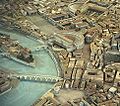Museo della Civiltà Romana
The Museo della Civiltà Romana ( German Museum of Roman Civilization ) is a museum in Rome that was fully opened on the Palilia in 1955 and is one of the municipal Musei in Comune . The exhibition is dedicated to the ancient Roman civilization , but the planetarium and the Museo Astronomico have also been housed in the premises since 2004 . The museum is located in the EUR district ( Esposizione Universale di Roma ), a district in the south of Rome that was laid out in the 1940s and 1950s. The museum has been closed for renovation work since 2014.
history
The neoclassical museum building, built at the time of fascism , was designed by the architect Pietro Aschieri and his colleagues Bernardini, Pascoletti and Peressutti. The architects won the tender as part of the world exhibition planned for 1942 in Rome , at which a separate complex was to be built on the site in the south of Rome. However, the world exhibition was canceled because of the Second World War and the museum remained unfinished until the end of the war.
The museum bases its holdings on an archaeological exhibition directed by Rodolfo Lanciani from 1911 as well as on the Museo dell'Impero Romano opened by Benito Mussolini in 1929 and the central exhibition on the two thousandth birthday of the Emperor Augustus , the Mostra Augustea della romanità from 1937, which also visited Adolf Hitler in 1938. The Museo dell'Impero Romano served ideological purposes: by emphasizing Roman antiquity as the foundation of Italian history and civilization, the importance of one's own nation was to be exaggerated for propaganda purposes.
Due to an urgent general renovation, the museum has been closed since January 2014. After initial preliminary investigations, it became clear that, for security reasons, the plan to leave individual rooms open for visits could not be carried out. Since, due to legal disputes so far no invitation was made of the work, the reopening is not yet in sight.
collection
The museum's collection largely includes reproductions, plaster casts and models, but also exhibits of Roman architecture , works of art, inscriptions and everyday objects. The entire area of the Roman Empire is covered. The 12,000 m² exhibition is divided into 59 sections. The objects on display also include plaster casts of the Trajan Column in Rome and a duplicate of the Great Mainz Column of Jupiter .
One room of the museum houses the model of the city of Rome created by Italo Gismondi in Constantinian times (4th century) on a scale of 1: 250. The model was created from 1933 and the city center was shown in 1937 at the Mostra Augustea della romanità . By 1955, the entire urban area within the Aurelian city wall was completed. The Forma Urbis Romae served as the basis . City districts for which no archaeological knowledge was available were filled with representative housing developments.
gallery
Detail from the model of Rome: the Marcellus Theater , behind it the Field of Mars
Plaster casts of the Trajan Column
Sarcophagus of Junius Bassus
Remarks
- ^ Forum Archaeologiae - Journal for Classical Archeology 43 / VI / 2007. Archeology and Fascism. The problematic relationship between archeology and politics in Fascist Italy.
- ^ Maria Rosaria Spadaccino: Resta chiuso il Museo della Civiltà Romana durante il Giubileo. In: Corriere della Sera . October 20, 2015, accessed November 12, 2016 .
Web links
- Website (English)
- Musei in Comune Roma (Italian, English)
Coordinates: 41 ° 49 ′ 55 " N , 12 ° 28 ′ 40.9" E







